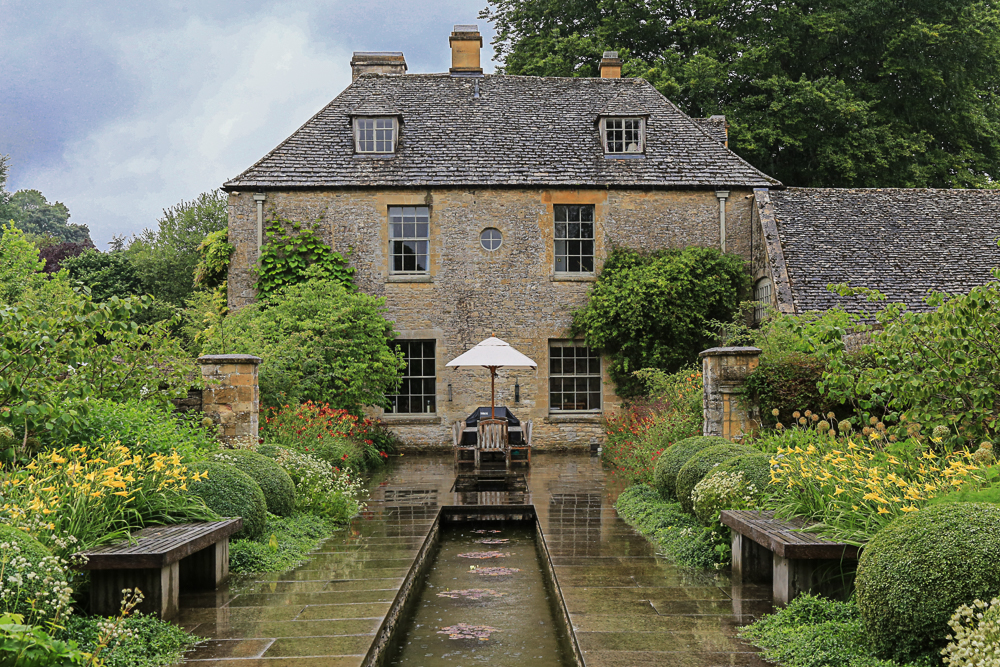The Old Rectory at Naunton
"I’ve always been drawn to plants which are on the wild side, drawn to gardens which are on the wild side, which feel like they might just be tumbling into something quite primitive and unmuddled with. The way I garden is to let things go almost to the brink of being lost, and that’s often quite a frightening thing to do."
Dan Pearson, BBC Desert Island Discs interview February 2015
While I was fortunate to meet and spend several happy hours with the owners and the gardeners of The Old Rectory at Naunton, I didn't attempt to take away their stories of the garden. This is a personal response to a garden that, on the surface, may appear to be merely an extraordinary ornament, but is much more.
. . . . . . . . . .
Even in the rain this is a stunning view of The Old Rectory at Naunton and its central canal garden, only one part of the larger garden designed by Dan Pearson. Phillip and I were fortunate to be able to visit it in July, and to spend a very special rainy afternoon with the owners and with their gardeners. The garden roots the house into a seemingly idyllic landscape bordered by a small river named Windrush on one side and by low hills on the other.Pearson's words, "to let things go almost to the brink of being lost," were in the back of my mind as we walked the garden that rainy afternoon, mainly because what I saw looked very much under control, or so I thought on first seeing it. Later I remembered being shown photos of the area after the river flooded, and that reminded me of the delicate balance in this place between tranquility and vulnerability. Then I began to perceive the wildness bursting out in the small meadows in the pool lawn, in the lush plantings around a mysterious green pond, in the perennial and shrub plantings opposite the swimming pool, even in the swelling borders flowing onto the paving in the canal garden above.All an illusion. Theater, but living theater subject to the vicissitudes of climate, topography, and time. This garden, and perhaps all gardens, becomes a place of memory, deep feeling, nostalgia. In a very real sense, the spirit of wildness, the proof of transience and vulnerability lingering in the atmosphere, is what gives this garden life. I'm reminded of Auden's phrase "wounded into art."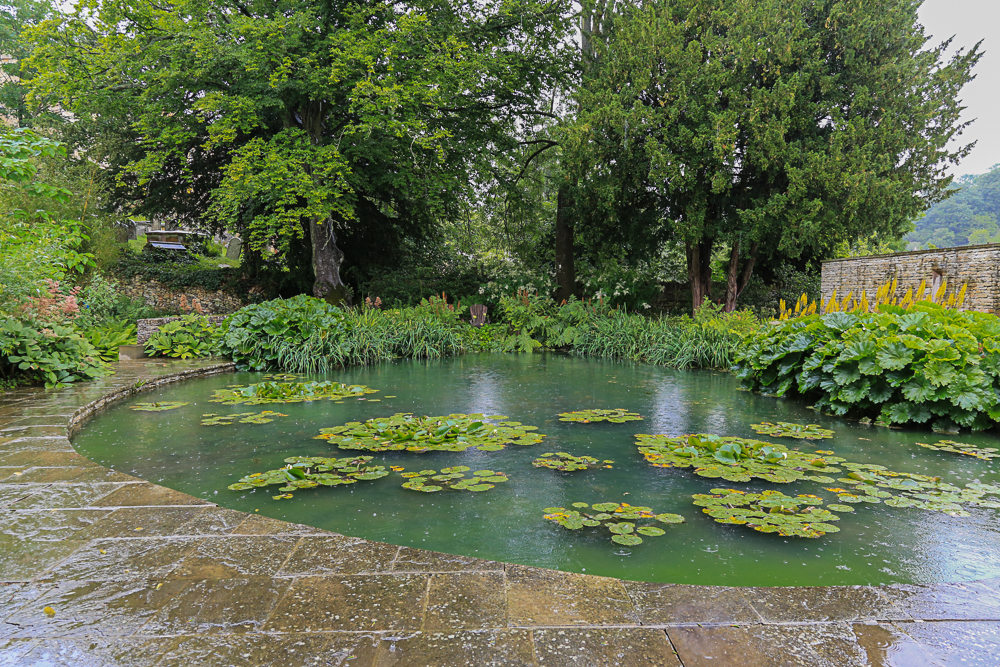 The garden at The Old Rectory is not formal, but highly structured, carefully ordered, made with precision. (Did I neglect to say beautiful?) The landscape, I'm given to understand, is a kind of palimpsest; here was an earlier garden, long decayed, with some similar features. But this garden was made totally anew, acknowledging the past and in so doing creating as near as possible a perfect setting for the 300-year-old house.The concept of palimpsest is a useful one. It suggests layering of the landscape over time. Faint, partially erased, but perceptible marks of the past--historical and cultural "writings"--remain; so the new garden is a metaphorical reincarnation of past gardens, occupying the same space like a kind of misty avatar made manifest.I like to imagine the Windrush was the starting point of the design, that the water, its movement, its sound, sets the garden into motion. Anyone who has read much of Dan Pearson's writing or seen his work knows he is exquisitely sensitive to context on multiple levels, to sense of place, so let's look at this place. On the face of it, this is a peaceful Cotswold village; one would think there is little to suggest a sense of unease here.
The garden at The Old Rectory is not formal, but highly structured, carefully ordered, made with precision. (Did I neglect to say beautiful?) The landscape, I'm given to understand, is a kind of palimpsest; here was an earlier garden, long decayed, with some similar features. But this garden was made totally anew, acknowledging the past and in so doing creating as near as possible a perfect setting for the 300-year-old house.The concept of palimpsest is a useful one. It suggests layering of the landscape over time. Faint, partially erased, but perceptible marks of the past--historical and cultural "writings"--remain; so the new garden is a metaphorical reincarnation of past gardens, occupying the same space like a kind of misty avatar made manifest.I like to imagine the Windrush was the starting point of the design, that the water, its movement, its sound, sets the garden into motion. Anyone who has read much of Dan Pearson's writing or seen his work knows he is exquisitely sensitive to context on multiple levels, to sense of place, so let's look at this place. On the face of it, this is a peaceful Cotswold village; one would think there is little to suggest a sense of unease here.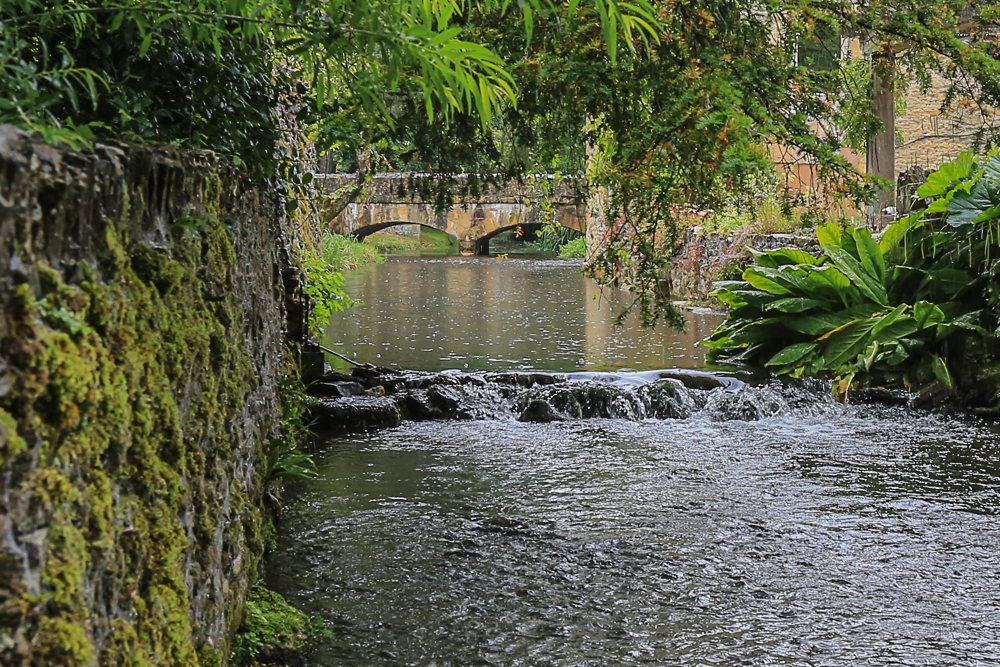 Here is the Windrush tumbling over a rocky weir beside The Old Rectory. The stone wall on the left protects the property, the house, and the garden from the river, which can, and has, turned destructive in the past. The river's presence brings a certain frisson to the garden that opens a door to emotion, as only the sense of nostalgia or loss, however gentle, can, waking the senses to heightened awareness.Gardens are places of tranquility, rest and safety. But the very need for these things, the desire for a tranquil, safe place, requires the possibility of the opposite. Why are fairy tales so fraught with fearful characters and dark woods? Without danger, there is no safety. Without disturbance, no tranquility. Strangely, danger appears to be invited into the garden (another bit of theater). A small canal feeds water straight from the river ...
Here is the Windrush tumbling over a rocky weir beside The Old Rectory. The stone wall on the left protects the property, the house, and the garden from the river, which can, and has, turned destructive in the past. The river's presence brings a certain frisson to the garden that opens a door to emotion, as only the sense of nostalgia or loss, however gentle, can, waking the senses to heightened awareness.Gardens are places of tranquility, rest and safety. But the very need for these things, the desire for a tranquil, safe place, requires the possibility of the opposite. Why are fairy tales so fraught with fearful characters and dark woods? Without danger, there is no safety. Without disturbance, no tranquility. Strangely, danger appears to be invited into the garden (another bit of theater). A small canal feeds water straight from the river ...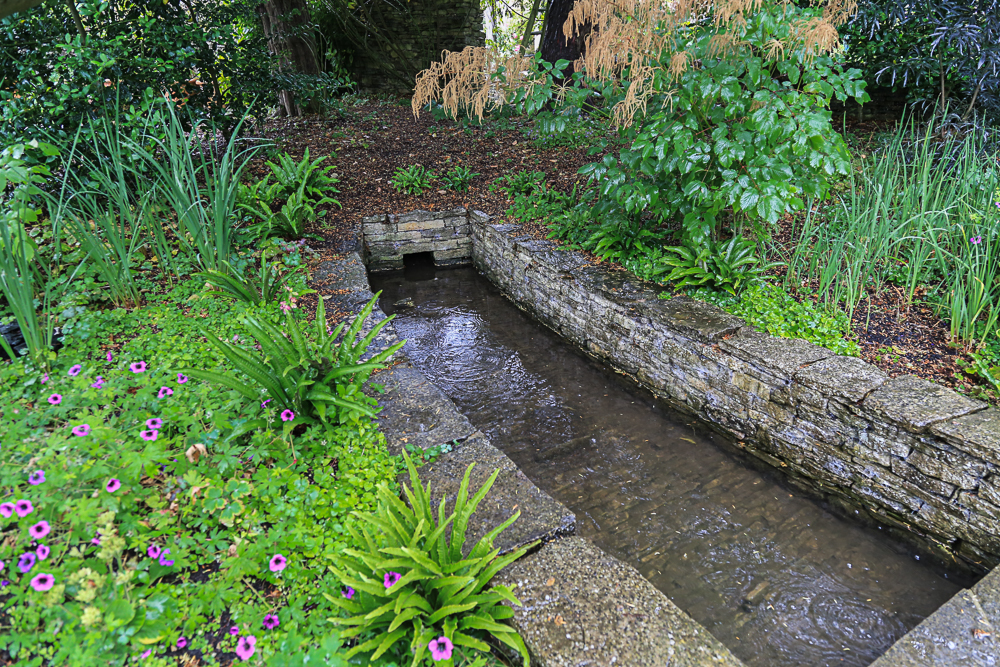 ... to a large, green pond. (The flow can be controlled or stopped with a valve mechanism, but the sense of the immanence of the river flowing in remains.) The green color of the pond immediately raises questions (why, how?), heightening attentiveness to the surroundings.
... to a large, green pond. (The flow can be controlled or stopped with a valve mechanism, but the sense of the immanence of the river flowing in remains.) The green color of the pond immediately raises questions (why, how?), heightening attentiveness to the surroundings.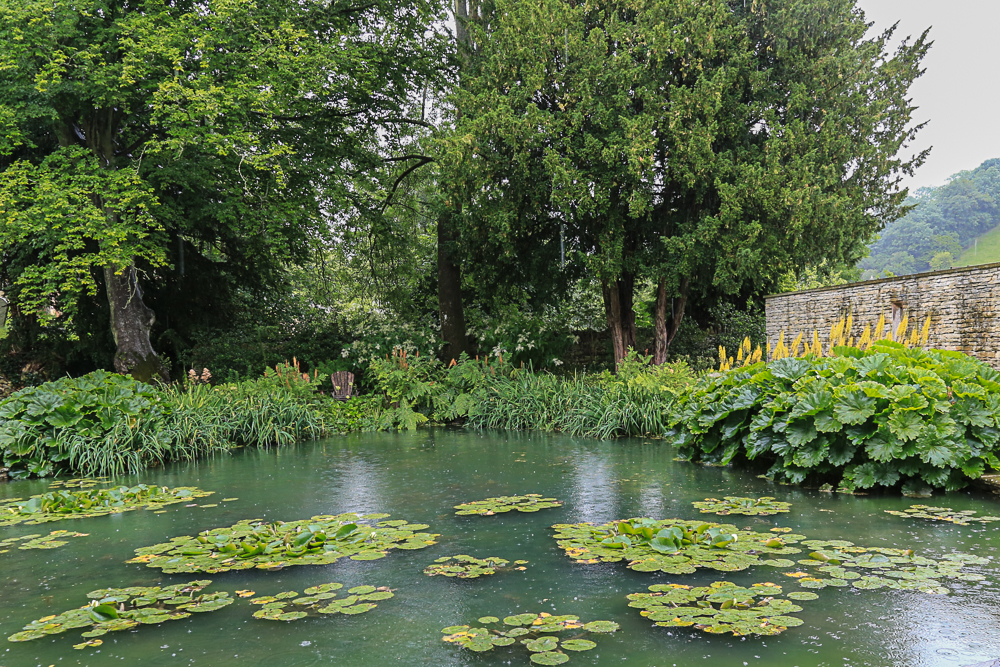 The scene evokes a feeling of something very old, even primal, mysterious, and that day in the rain, melancholy.
The scene evokes a feeling of something very old, even primal, mysterious, and that day in the rain, melancholy.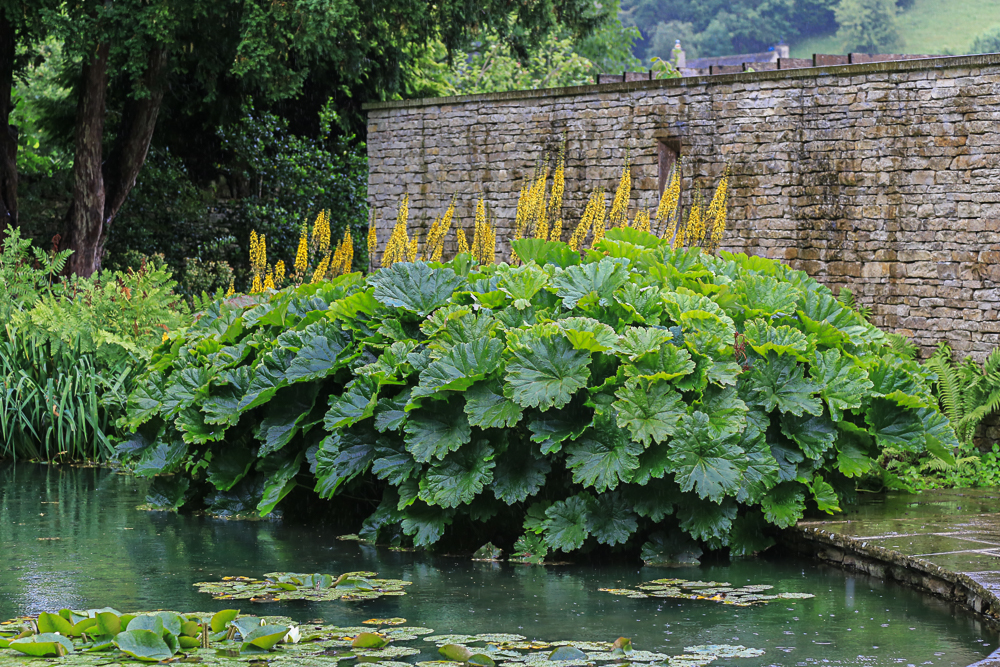 But I have seen images of this part of the garden in pleasant weather and the effect is quite different--a peaceful, meditative setting without a trace of melancholy. Only trickling water and the whisper of wind in the trees. So the pond garden does double duty, harkening back to primal origin then moving onward to a bright new day, a feeling of something wonderful about to happen, as in Botticelli's Birth of Venus but here without the Venus. In its place, the yellow spires of Ligularia stenocephala and lush, mounding Darmera peltata rise from the plane of the water, a dramatic upward gesture, like an upturned hand.Imagine sitting in that shady Adirondack chair hidden back in the shadows, enfolded by the voluptuous water plants crowding the pond's edge. You can linger there in tranquility among masses of Darmera, Iris 'Gerald Darby', Osmunda, Typha, various primulas ...
But I have seen images of this part of the garden in pleasant weather and the effect is quite different--a peaceful, meditative setting without a trace of melancholy. Only trickling water and the whisper of wind in the trees. So the pond garden does double duty, harkening back to primal origin then moving onward to a bright new day, a feeling of something wonderful about to happen, as in Botticelli's Birth of Venus but here without the Venus. In its place, the yellow spires of Ligularia stenocephala and lush, mounding Darmera peltata rise from the plane of the water, a dramatic upward gesture, like an upturned hand.Imagine sitting in that shady Adirondack chair hidden back in the shadows, enfolded by the voluptuous water plants crowding the pond's edge. You can linger there in tranquility among masses of Darmera, Iris 'Gerald Darby', Osmunda, Typha, various primulas ...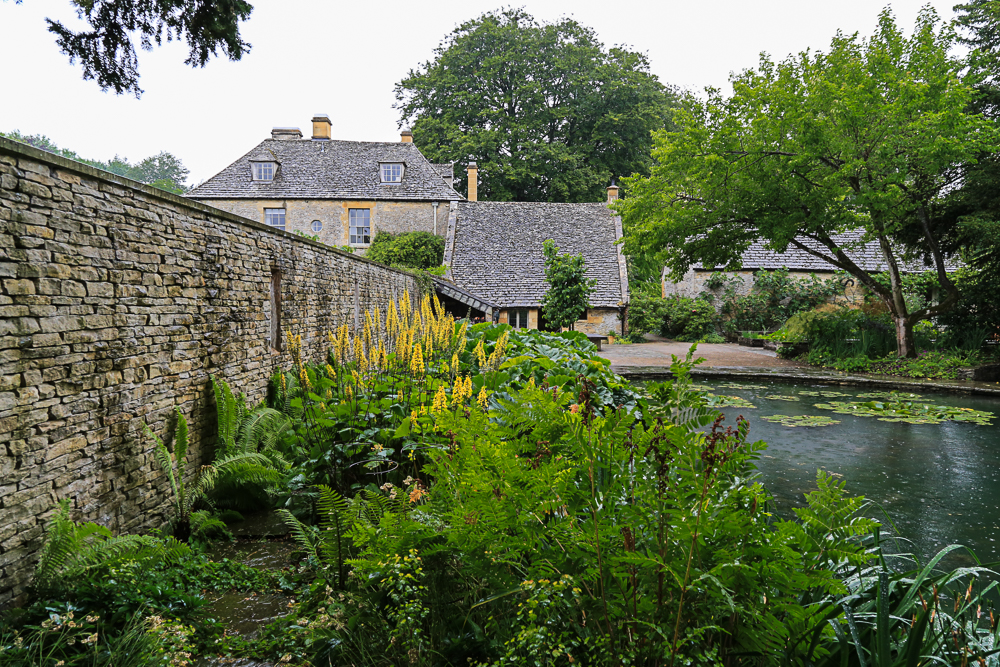 ... or move to the other side of the wall, where you enter a different world, the canal garden, where water appears again, though here in strict geometric form.
... or move to the other side of the wall, where you enter a different world, the canal garden, where water appears again, though here in strict geometric form.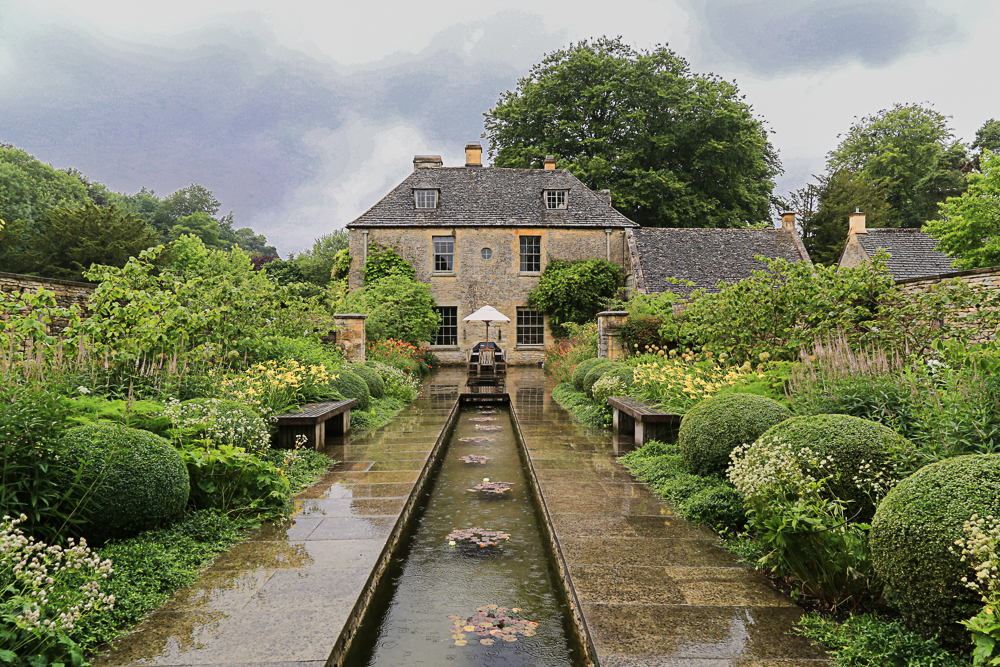 The parallel lines, the powerful perspective create a riveting scene, quickly drawing your eyes down the canal to the house, then freeing you to enjoy the lavish plantings. The axial design makes it absolutely clear the house is the center of this garden. But any temptation to see the garden as formal is quickly dispatched by the lush and varied plantings that almost erase the parallel stone walls, by irregular, rhythmic episodes along the length of the canal--the box balls, the low seats, the crossing walls and "bridge" partway toward the house--so that the sense is of a bountiful, exuberant growth that might just overpower the strict confines of the structure. You don't want to take your eyes away from this mesmerizing scene.A closer view of the "hot" borders near the house reveals, among many other things, bright red Hemerocallis Stafford, Astrantia 'Hadspen's Blood', Persicaria amplexicaulis, and tall Rosa moyesii 'Geranium', and makes a dramatic contrast with the pale yellow daylilies and soft colors at the further end of the canal. (I remember seeing the Geranium rose in October at Sissinghurst about 30 years ago; the large hips were so colorful, I at first thought the roses were still in flower.) The rose canes will become a fountain of orange in autumn.
The parallel lines, the powerful perspective create a riveting scene, quickly drawing your eyes down the canal to the house, then freeing you to enjoy the lavish plantings. The axial design makes it absolutely clear the house is the center of this garden. But any temptation to see the garden as formal is quickly dispatched by the lush and varied plantings that almost erase the parallel stone walls, by irregular, rhythmic episodes along the length of the canal--the box balls, the low seats, the crossing walls and "bridge" partway toward the house--so that the sense is of a bountiful, exuberant growth that might just overpower the strict confines of the structure. You don't want to take your eyes away from this mesmerizing scene.A closer view of the "hot" borders near the house reveals, among many other things, bright red Hemerocallis Stafford, Astrantia 'Hadspen's Blood', Persicaria amplexicaulis, and tall Rosa moyesii 'Geranium', and makes a dramatic contrast with the pale yellow daylilies and soft colors at the further end of the canal. (I remember seeing the Geranium rose in October at Sissinghurst about 30 years ago; the large hips were so colorful, I at first thought the roses were still in flower.) The rose canes will become a fountain of orange in autumn.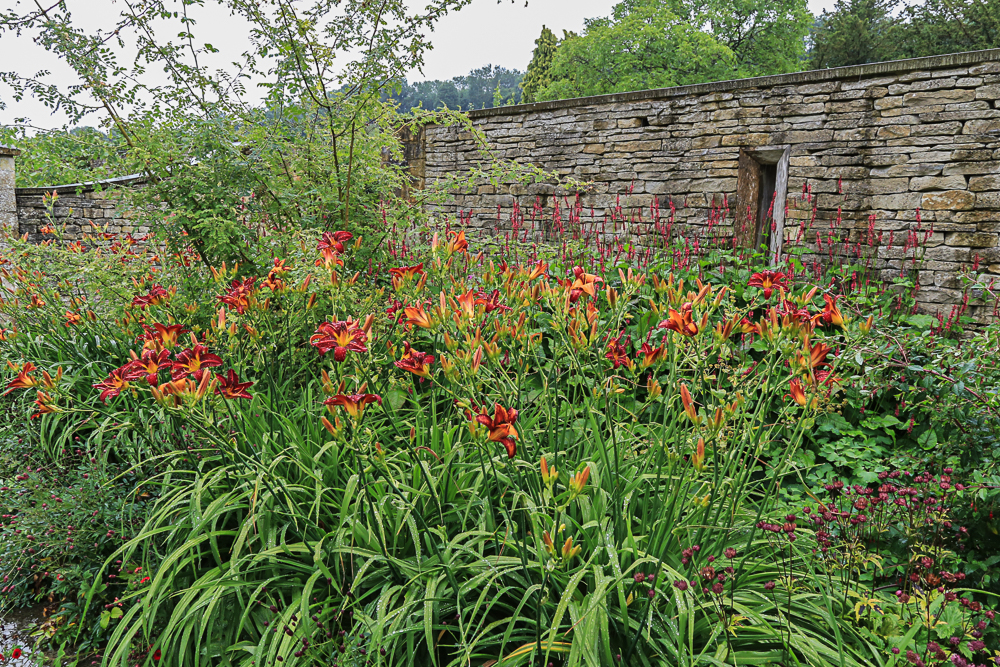 I wish I could have asked more questions about individual plants, but with rain coming steadily down, walking in starts and stops, asking about this and that plant, wasn't possible.
I wish I could have asked more questions about individual plants, but with rain coming steadily down, walking in starts and stops, asking about this and that plant, wasn't possible.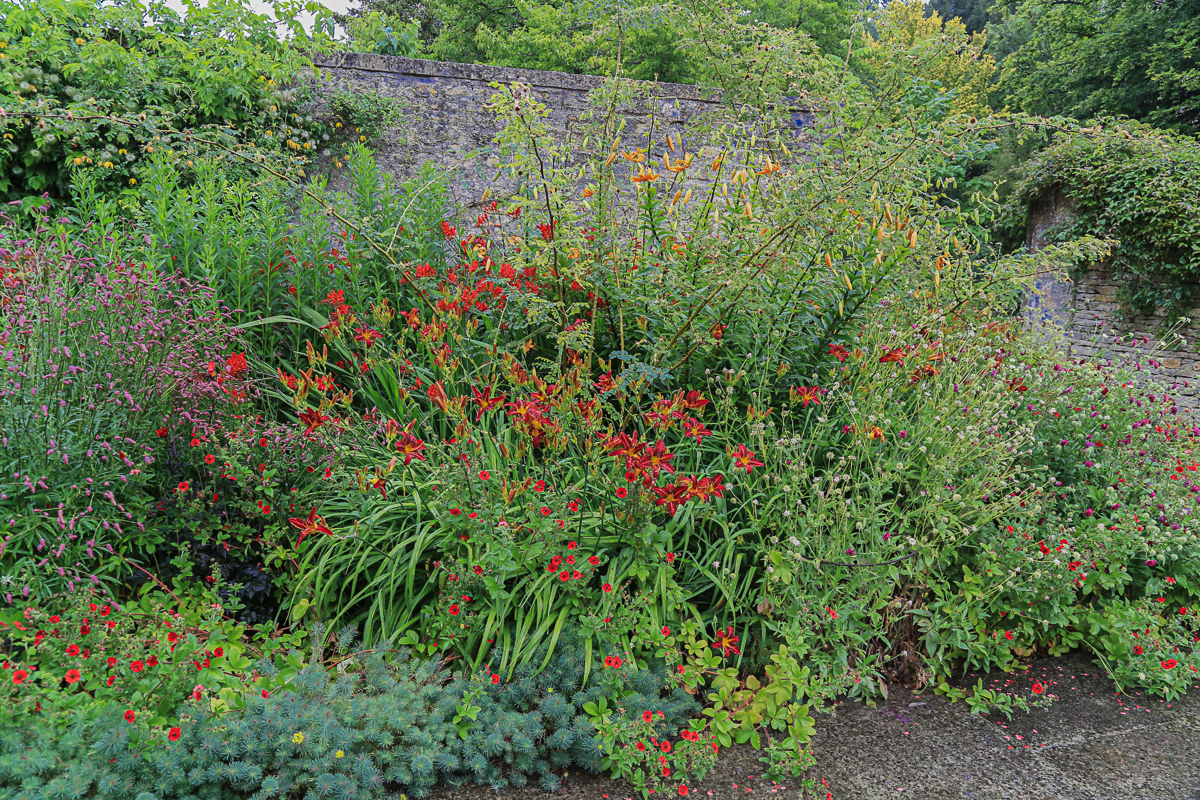 This is the view looking out from the informal kitchen dining area. We would have eaten lunch outside had the rain waited for another day.
This is the view looking out from the informal kitchen dining area. We would have eaten lunch outside had the rain waited for another day.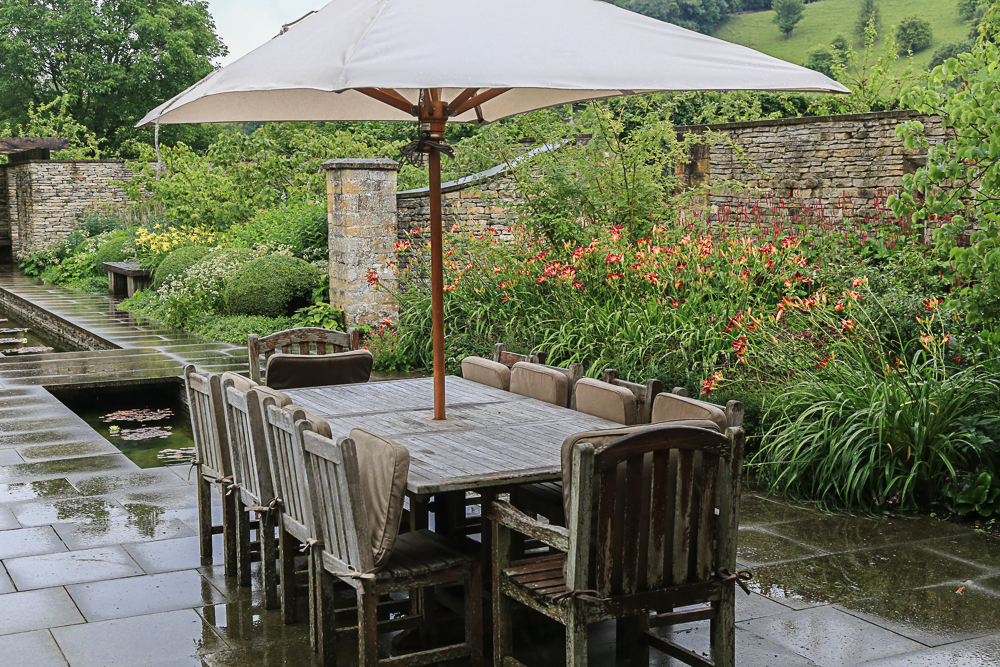 All the walls are dry laid stone. They are a completely new addition designed by Dan Pearson; the workmanship is of extraordinary quality. The pergola area at the end of the canal, opposite the house, reminds me very much of a Frank Lloyd Wright design ...
All the walls are dry laid stone. They are a completely new addition designed by Dan Pearson; the workmanship is of extraordinary quality. The pergola area at the end of the canal, opposite the house, reminds me very much of a Frank Lloyd Wright design ...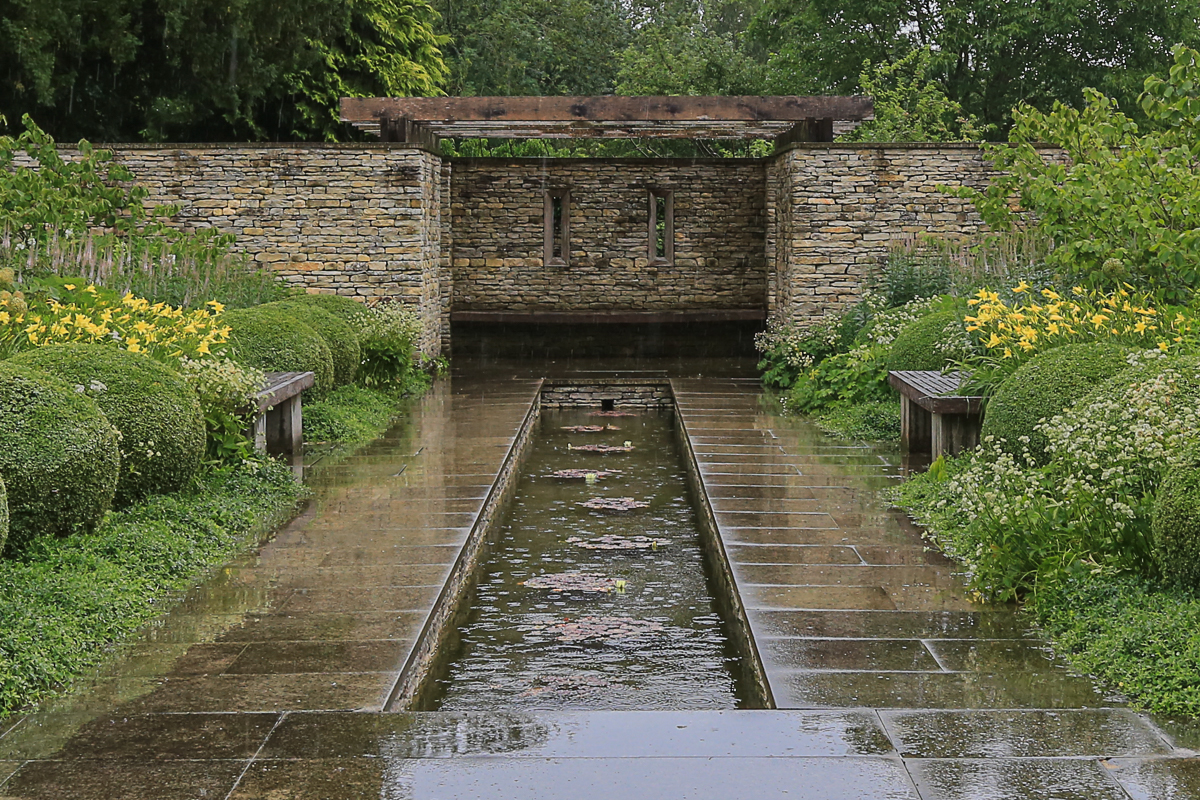 ... a modernist touch I found pleasing, and a testament to Pearson's success in integrating new and old. A passageway in front of the back wall carries you from the pond garden on the left through to the lawn and swimming pool on the right.Pearson designed arrow slit openings of green oak to allow glimpses to other parts of the garden through the stone walls. Below, you can see how intriguing are the views through the narrow slits. The rectangular shape of the slits echoes the rectangle of the canal garden, and a pattern of rectangular shapes used even more generously in the next area of the garden.
... a modernist touch I found pleasing, and a testament to Pearson's success in integrating new and old. A passageway in front of the back wall carries you from the pond garden on the left through to the lawn and swimming pool on the right.Pearson designed arrow slit openings of green oak to allow glimpses to other parts of the garden through the stone walls. Below, you can see how intriguing are the views through the narrow slits. The rectangular shape of the slits echoes the rectangle of the canal garden, and a pattern of rectangular shapes used even more generously in the next area of the garden.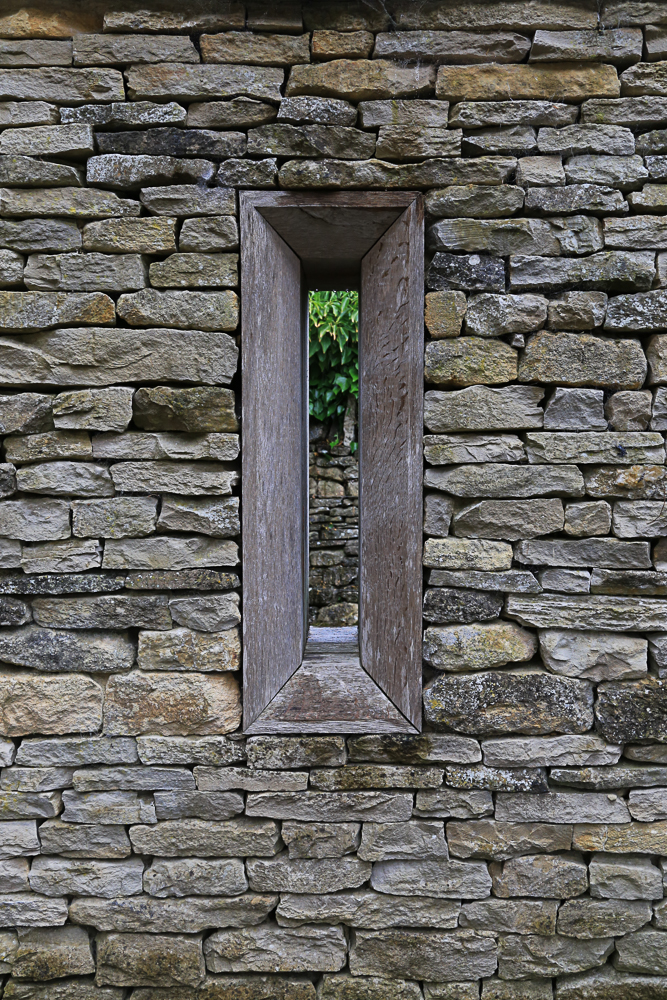 Continuing through the passageway at the back of the canal garden, you move through a constricted space, then experience a sudden opening as you enter the area of the lawn and pool, encountering water a third time. You can just glimpse an edge of one small meadow on the right.
Continuing through the passageway at the back of the canal garden, you move through a constricted space, then experience a sudden opening as you enter the area of the lawn and pool, encountering water a third time. You can just glimpse an edge of one small meadow on the right.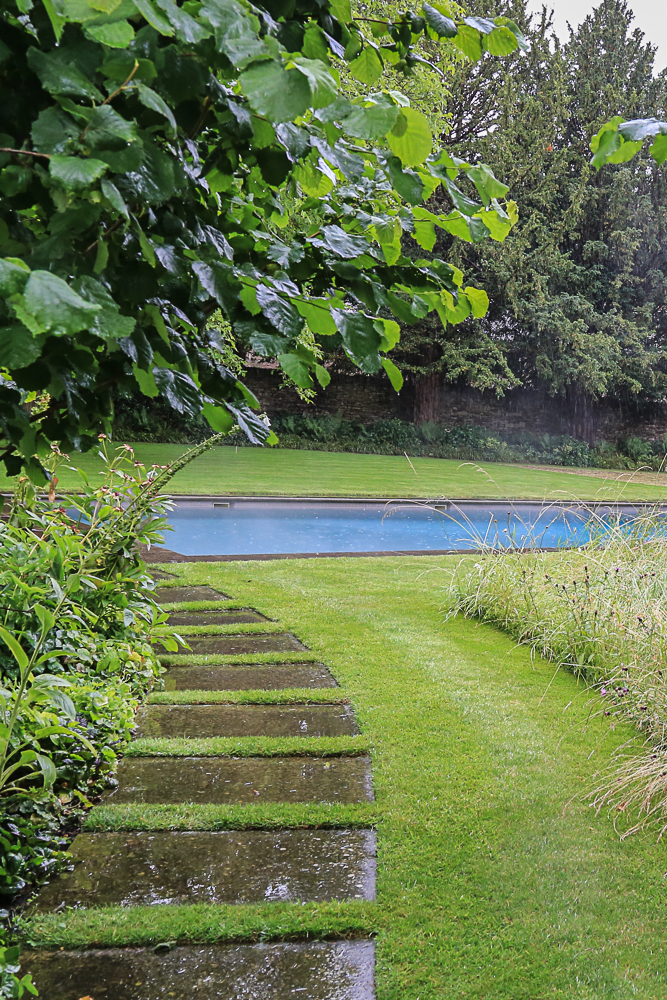 A further turn to the right and you can see "the wild side" again. This view of the house through apple trees and a small meadow looks quite wild compared to the canal garden only a few feet away. Dan Pearson's ability to combine such radically different scenes into a unified vision is one of his hallmarks. I think he does this through very effective use of spatial and emotional (they can be the same) transitions. As you move from the pond garden, to the canal garden, to the open area of the pool and lawn, you also move through a series of alternating compressive and expansive spaces created by the walls at the back of the canal garden. This repeated opening and closing has a theatrical aspect, and makes the garden more interesting by manipulating your emotions in a very subtle way. (I found similar effects when visiting Rousham.)
A further turn to the right and you can see "the wild side" again. This view of the house through apple trees and a small meadow looks quite wild compared to the canal garden only a few feet away. Dan Pearson's ability to combine such radically different scenes into a unified vision is one of his hallmarks. I think he does this through very effective use of spatial and emotional (they can be the same) transitions. As you move from the pond garden, to the canal garden, to the open area of the pool and lawn, you also move through a series of alternating compressive and expansive spaces created by the walls at the back of the canal garden. This repeated opening and closing has a theatrical aspect, and makes the garden more interesting by manipulating your emotions in a very subtle way. (I found similar effects when visiting Rousham.)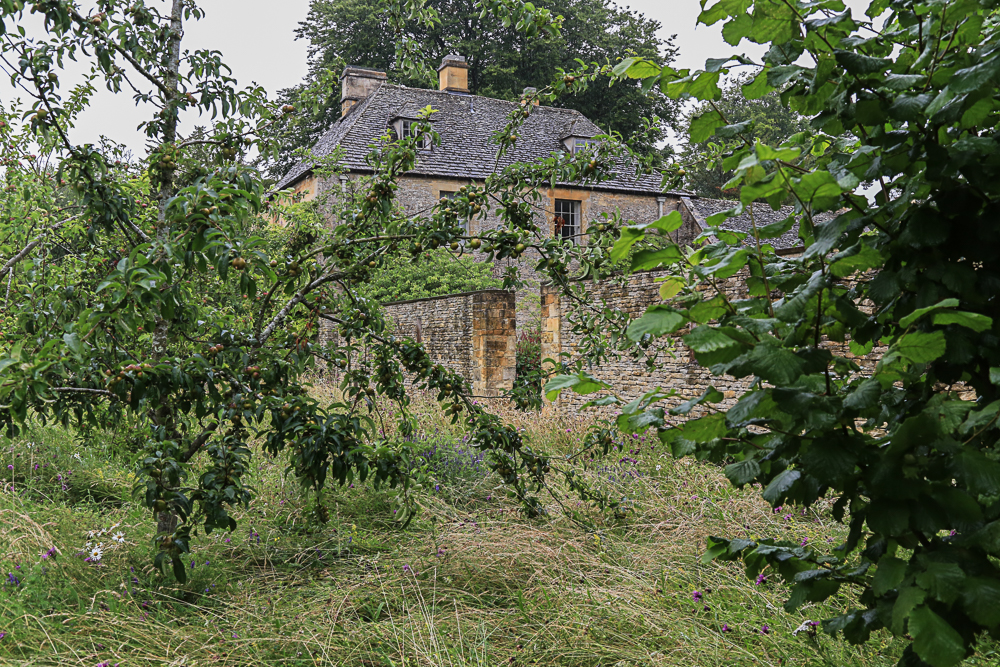 Although taking photographs under an umbrella in the rain doesn't produce optimum images, I show this view of the lawn because it's essential to seeing how the parts of the garden fit together. Looking down the length of the pool, the rectangular meadow on the right reflects the rectangular shape of the pool. Not visible now, because it was recently cut, is another smaller meadow under the Gleditsia on the left. You can see its brown footprint. These shapes, in turn are echoed by low squares of box topiary used at the far end of the garden, several with Amelanchier growing out of their centers. In the center distance is the tower of the church, a fitting end point for this part of the garden at The Old Rectory.
Although taking photographs under an umbrella in the rain doesn't produce optimum images, I show this view of the lawn because it's essential to seeing how the parts of the garden fit together. Looking down the length of the pool, the rectangular meadow on the right reflects the rectangular shape of the pool. Not visible now, because it was recently cut, is another smaller meadow under the Gleditsia on the left. You can see its brown footprint. These shapes, in turn are echoed by low squares of box topiary used at the far end of the garden, several with Amelanchier growing out of their centers. In the center distance is the tower of the church, a fitting end point for this part of the garden at The Old Rectory.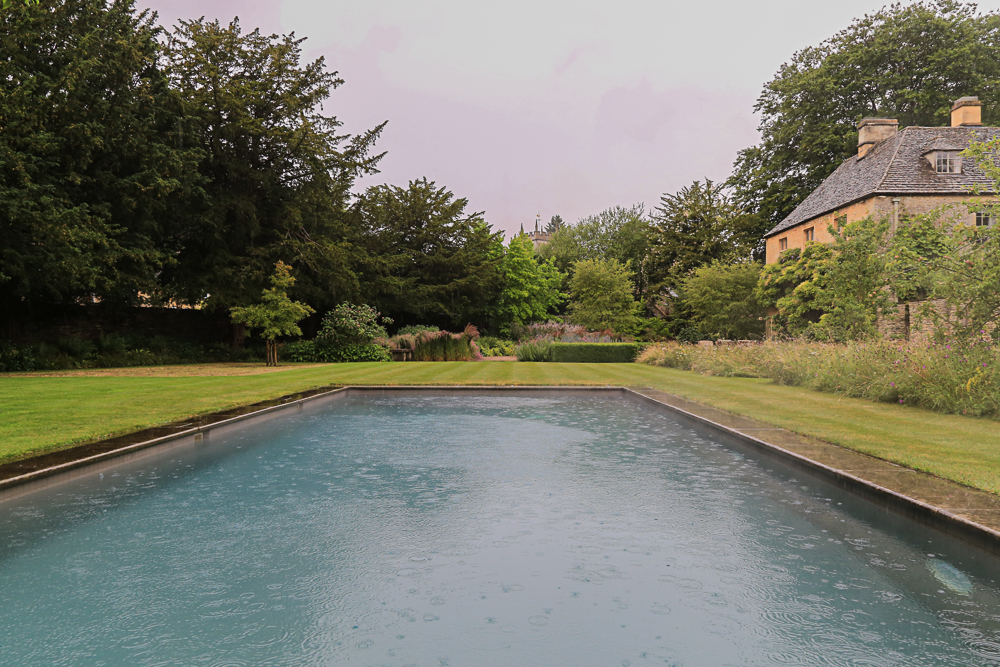 Moving on to this prospect on the far side of the lawn, you can see the remnants of the recently cut smaller meadow and, in the left mid-distance, one of several low box squares used as a motif on this side and in the front garden. The two openings in the stone wall of the canal garden allow, on the right, passage through to the pond garden and the Windrush and, on the left, to the "hot" borders and outdoor dining area. Though the garden is slightly over one acre in size, Pearson's design keeps all parts in close relationship to the house--the center of it all--and to each other, so you never lose intimacy with the house or easy access to other parts of the garden.
Moving on to this prospect on the far side of the lawn, you can see the remnants of the recently cut smaller meadow and, in the left mid-distance, one of several low box squares used as a motif on this side and in the front garden. The two openings in the stone wall of the canal garden allow, on the right, passage through to the pond garden and the Windrush and, on the left, to the "hot" borders and outdoor dining area. Though the garden is slightly over one acre in size, Pearson's design keeps all parts in close relationship to the house--the center of it all--and to each other, so you never lose intimacy with the house or easy access to other parts of the garden.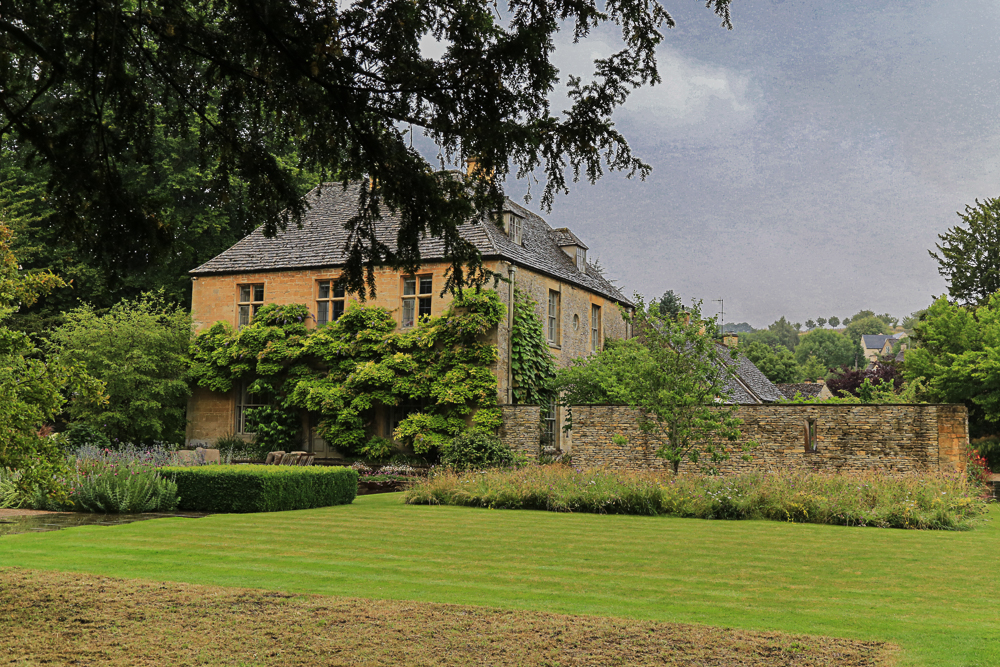 The color transitions in the three major parts of the garden are quite dramatic.In the garden beside the outdoor terrace a completely different color palette is used : pinks, blues, mauves of Dianthus carthusianorum, Dierama pulcherrima, Echinops 'Veitch's Blue', Eryngium x tripartitum, Lychnis coronaria, Perovskia atriplicifolia 'Blue Spire', Stachys byzantina, Verbena bonariensis, and in the background Calamagrostis x acutiflora 'Karl Foerster' (weeping in the rain) and Veronicastrum virginicum 'Lavendelturm'.
The color transitions in the three major parts of the garden are quite dramatic.In the garden beside the outdoor terrace a completely different color palette is used : pinks, blues, mauves of Dianthus carthusianorum, Dierama pulcherrima, Echinops 'Veitch's Blue', Eryngium x tripartitum, Lychnis coronaria, Perovskia atriplicifolia 'Blue Spire', Stachys byzantina, Verbena bonariensis, and in the background Calamagrostis x acutiflora 'Karl Foerster' (weeping in the rain) and Veronicastrum virginicum 'Lavendelturm'.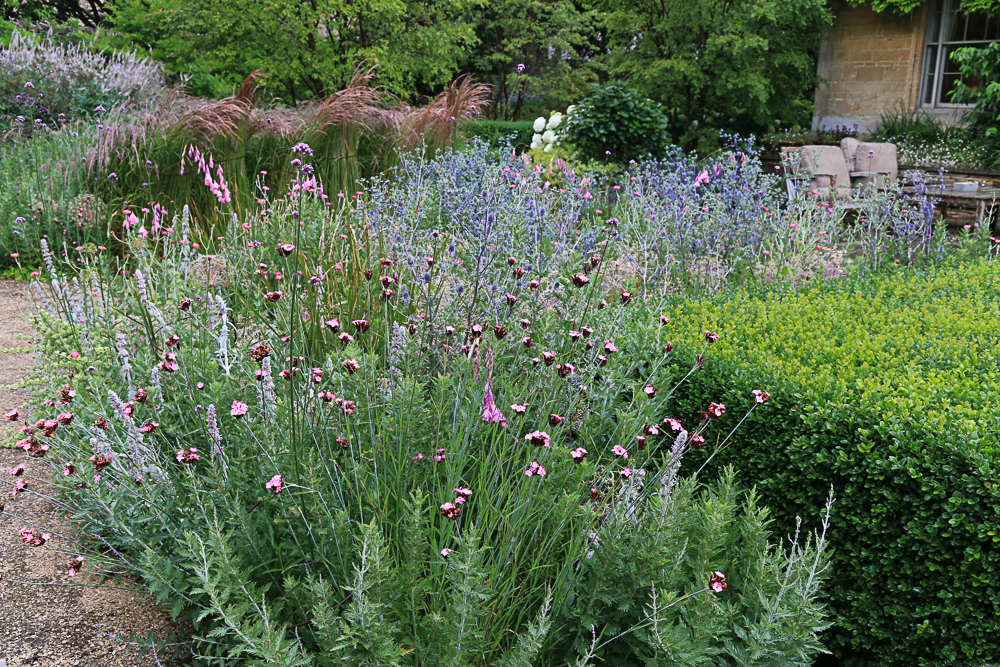 Looking from near the house and across the terrace toward the pool at the back, you see repetition of rectangles in various forms (theme and variations): the stone terrace itself shining in the rain, rectangular box hedges, the uncut meadow straight ahead, pleached hornbeams making an elevated rectangle behind the pool, the pool itself, the large rectangle of lawn, the rectangular lavender plantings in the terrace, the vertical wall of the canal garden. There is an almost musical interplay in the garden as a whole, from the curves and irregularities of the pond garden, to the vanishing point perspective of the canal garden, to the flat stability and varied textures, colors, and reflective surfaces of the lawn and surrounding geometries.
Looking from near the house and across the terrace toward the pool at the back, you see repetition of rectangles in various forms (theme and variations): the stone terrace itself shining in the rain, rectangular box hedges, the uncut meadow straight ahead, pleached hornbeams making an elevated rectangle behind the pool, the pool itself, the large rectangle of lawn, the rectangular lavender plantings in the terrace, the vertical wall of the canal garden. There is an almost musical interplay in the garden as a whole, from the curves and irregularities of the pond garden, to the vanishing point perspective of the canal garden, to the flat stability and varied textures, colors, and reflective surfaces of the lawn and surrounding geometries.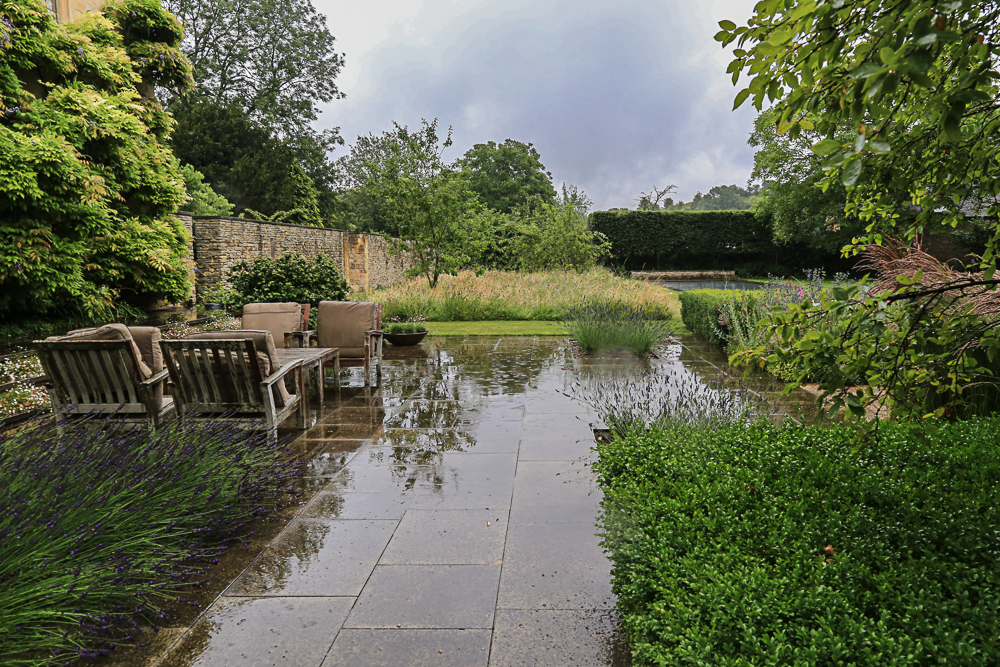 So where do I find my theme--"the wild side"--now? Yes, it's still here. This whole side of the garden is one giant rectangle erupting into smaller rectangles, like a quantum field generating unexpected parts, perhaps magical, impossible new things. I find this view immensely pleasing. It so well captures the spirit of wildness with painterly frames, entertains the vision and the mind with spatial satisfactions, and appeals to a sense of order amid chaos that may be a synonym for paradise.
So where do I find my theme--"the wild side"--now? Yes, it's still here. This whole side of the garden is one giant rectangle erupting into smaller rectangles, like a quantum field generating unexpected parts, perhaps magical, impossible new things. I find this view immensely pleasing. It so well captures the spirit of wildness with painterly frames, entertains the vision and the mind with spatial satisfactions, and appeals to a sense of order amid chaos that may be a synonym for paradise.
. . . . . . . .
For views of the garden not taken in the rain, click this link to Dan Pearson Studio.
For an extraordinary 18 minute video of the garden, watch this:
https://vimeo.com/67923800
